Just like the spectators, the athletes had strong opinions on the routesetting at the Budapest OQS.
“I found the [qualification] route a bit boring”. “I found the routesetting a bit shit in the final”. “All the rest were just jumps”.
Competition routesetting competition is an incredibly hard job.
The routesetters have to balance setting climbs the athletes can express themselves on, creating climbs that separate the athletes and test the best, and creating a show which excites and entertains the audience.
Their job is further complicated by the new combined format where the routesetters have strict guidelines on what styles to set in and have to incorporate an extra intermediate scoring hold. They need to target not only a number of tops but also a spread of scores to balance Lead and Boulder.
All while working into the early hours of the morning to try to get the climbs rights.
In Budapest, I talked with three of the routesetting team: Lead routesetter Adam Pustelnik, Boulder routesetter Olga Niemiec and local Hungarian routesetter Barna Kerényi who joined the Boulder team.
They shared with me what they learned from Budapest and the challenges of routesetting for the very best.
IFSC Boulder&Lead Setting Guidelines
Unlike in World Cups, the routesetters have specific guidelines from the IFSC on routesetting for the Boulder&Lead combined format.
In Boulder&Lead, there are 4 boulders in each round. Two are more traditional climbing, 1 technical and 1 physical, while the other two embrace the modern style: 1 pure coordination boulder with multiple movements and the other “electric”. Electric boulders feature a combination of power and coordination where athletes move explosively between static positions with one or two movements.
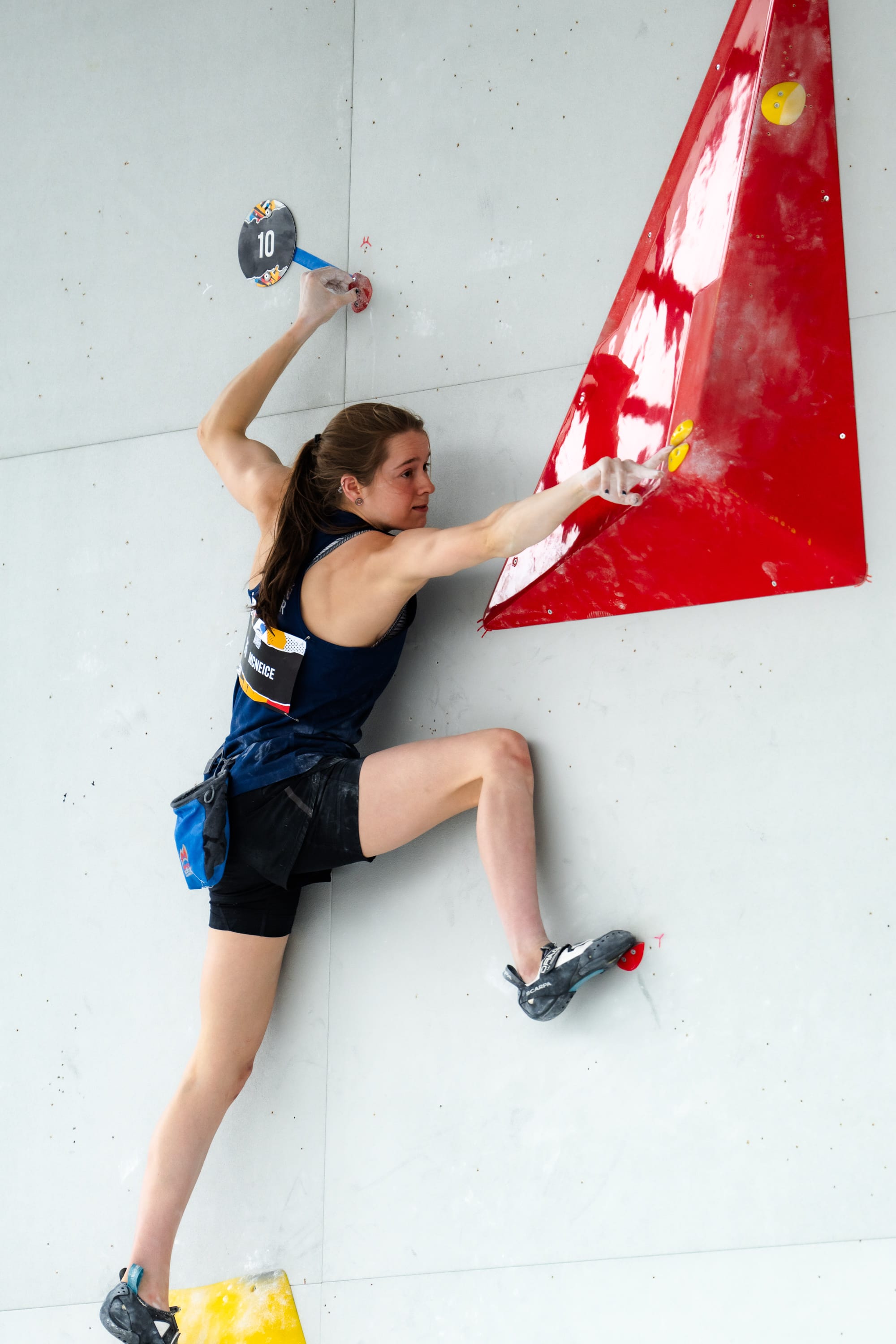
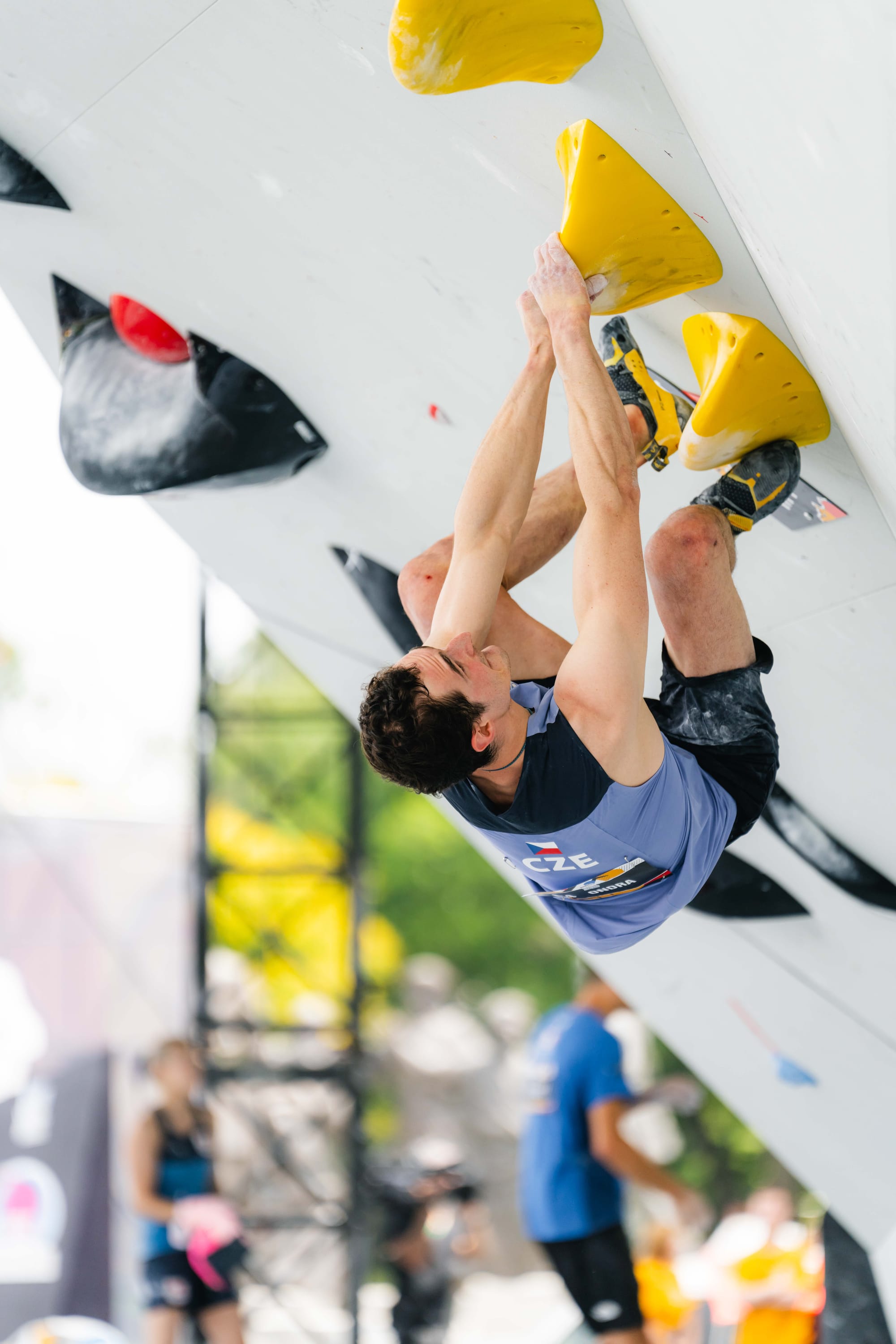
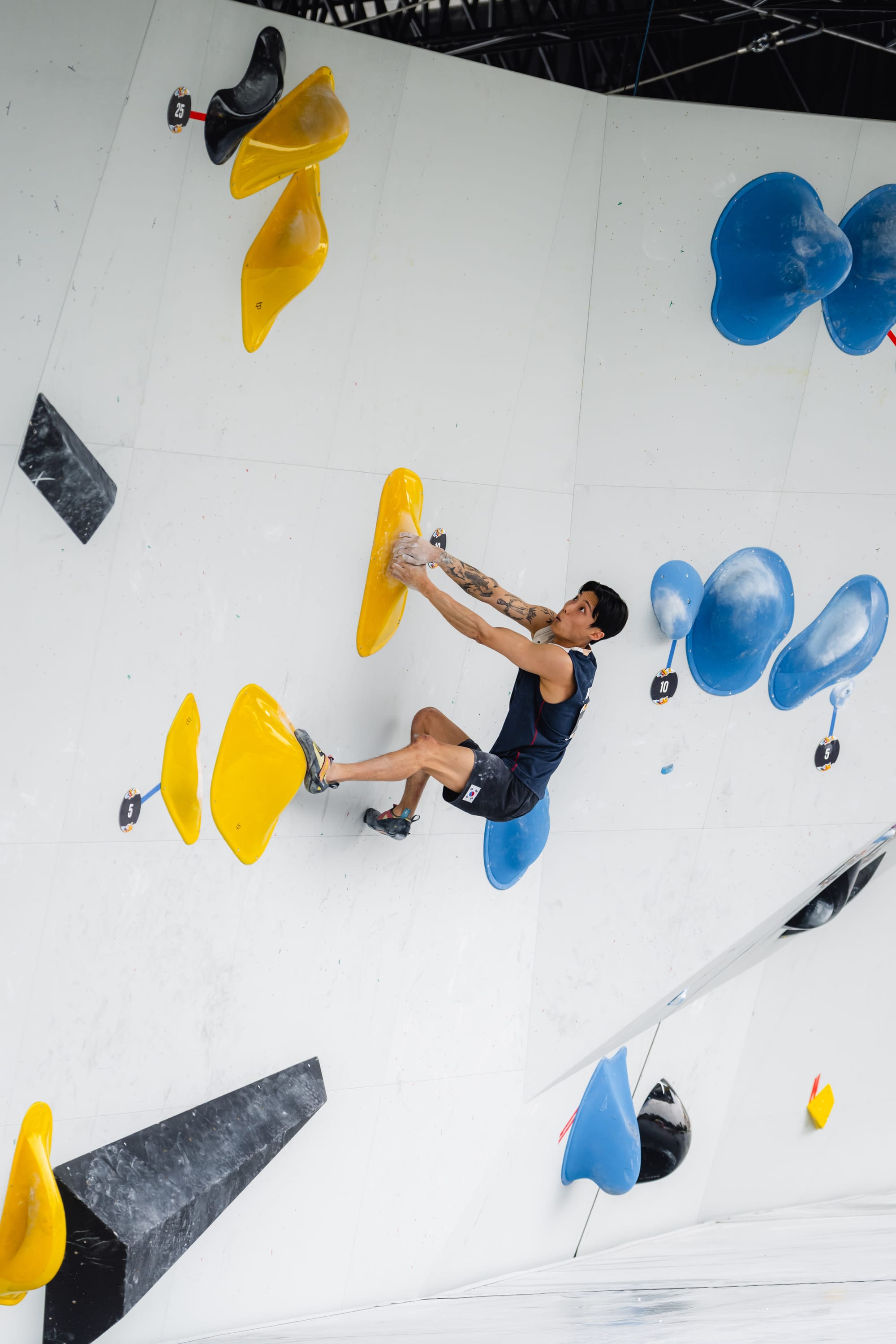
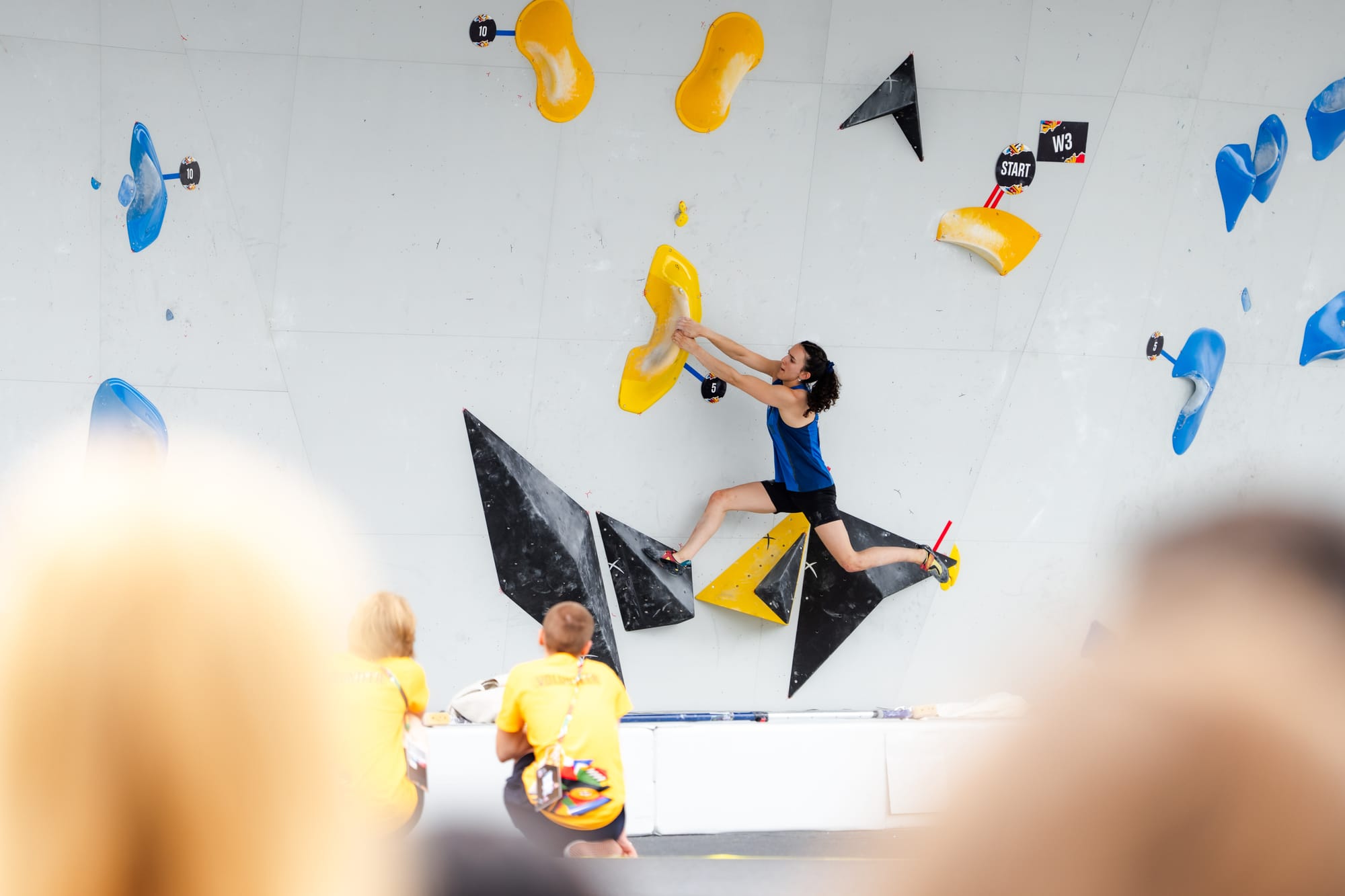
4 different styles of boulder in Boulder&Lead: Technical, Physical, Coordination and Electric © Lena Drapella / IFSC
“You are in a position, and from that position, you can only get to the next position by doing some dynamic moves where you have to coordinate two limbs.” Barna Kerényi described the electric style to me. “Maybe the two hands together or one hand, one foot. It’s not coordination yet because in coordination, you have to think of at least three different movements at the same time. Electric is a little bit more simple and more powerful. It’s a mixture of coordination and basic power.”
The Boulder wall at the Budapest OQS event was similar to the wall used at the Bern 2023 World Championship and at the Olympics: the Titan Bouldering Wall from Entre-Prise Climbing. The Boulder wall in Budapest had similar angles to the Titan but was much wider as the routesetters needed to set 8 boulder problems on the wall for the qualification and semi-final rounds, something they won’t need to do in Paris as the male and female athletes compete on different days.
The Titan wall looks like it has been designed for these 4 different styles of boulders. The technical boulders have been set on the vertical section (0º) on the left-hand side going into the corner section, with routesetters relying on large volumes and macros to create as much of a slab as they want. The steep roof lends itself to the more physical boulders. The coordination and electric boulders are left with the less steep sections in the middle.
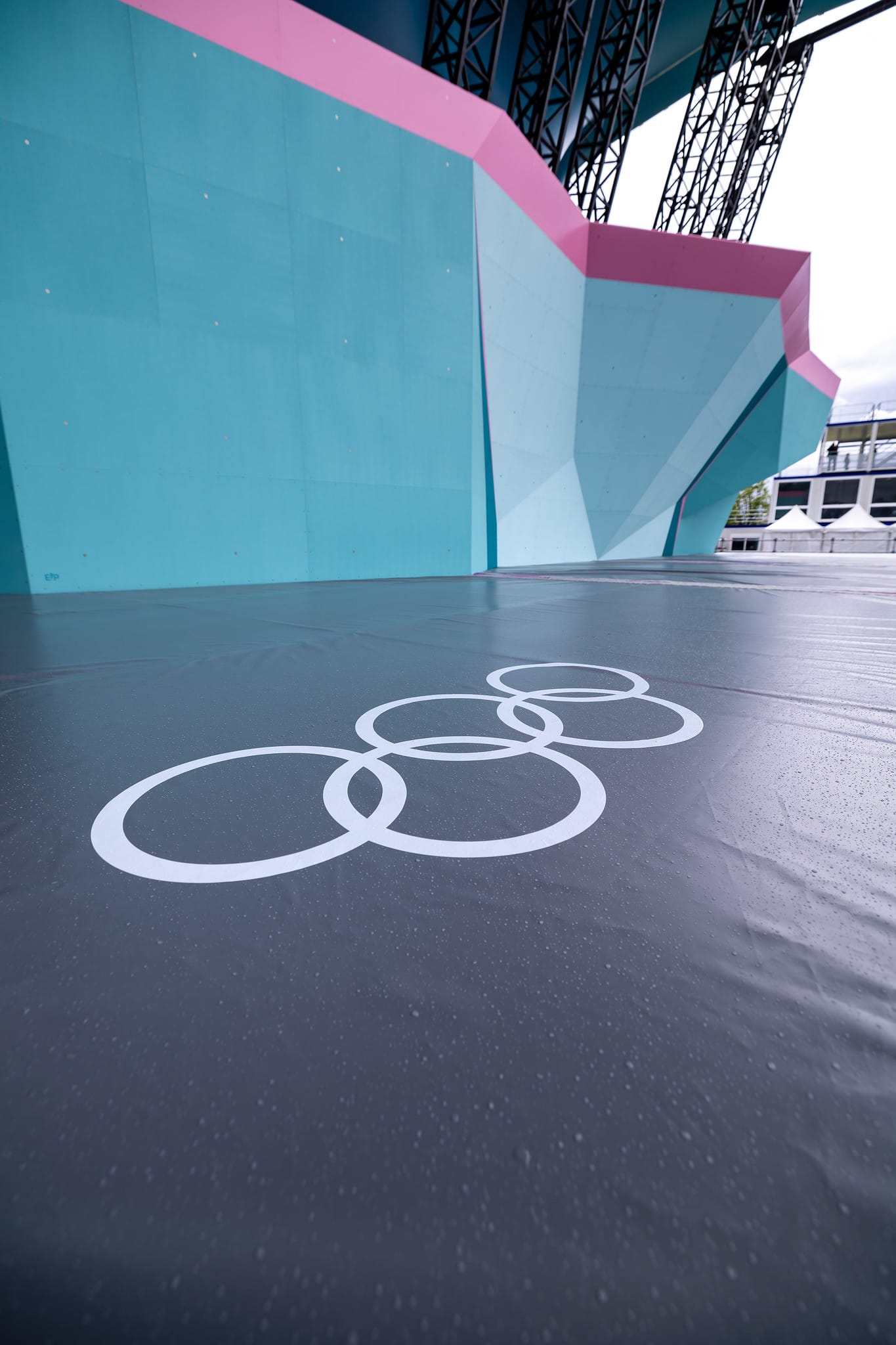
The style of the boulders must remain consistent for each boulder. Though there can still be some jumps or physical moves, they can’t stray far from the intended style for the whole boulder. The physical boulder needs to remain physical in each section. The coordination and electric boulders often become a series of 3 dynamic moves, each between a scoring hold. The technical boulder won’t have a large electric jump like in some world cups.
The lead route guidelines are simpler; just keep the route between 40–50 moves. This is needed as only the top 40 holds are score points. The IFSC also wants, ideally, to have only one top, which is an incredibly hard challenge.
The routes in the combined format are “classic” endurance routes, focusing on testing the endurance of athletes more than how they deal with risky moves which have started crossing over from bouldering in Lead World Cups. “I found that the style of the route has gone back to what it was when I first started doing world cups.” Molly Thompson-Smith said after the Lead qualification round. “It’s just a pure test of endurance and power endurance and decision making when you’re fatigued. It’s been a joy to climb routes in this format.”
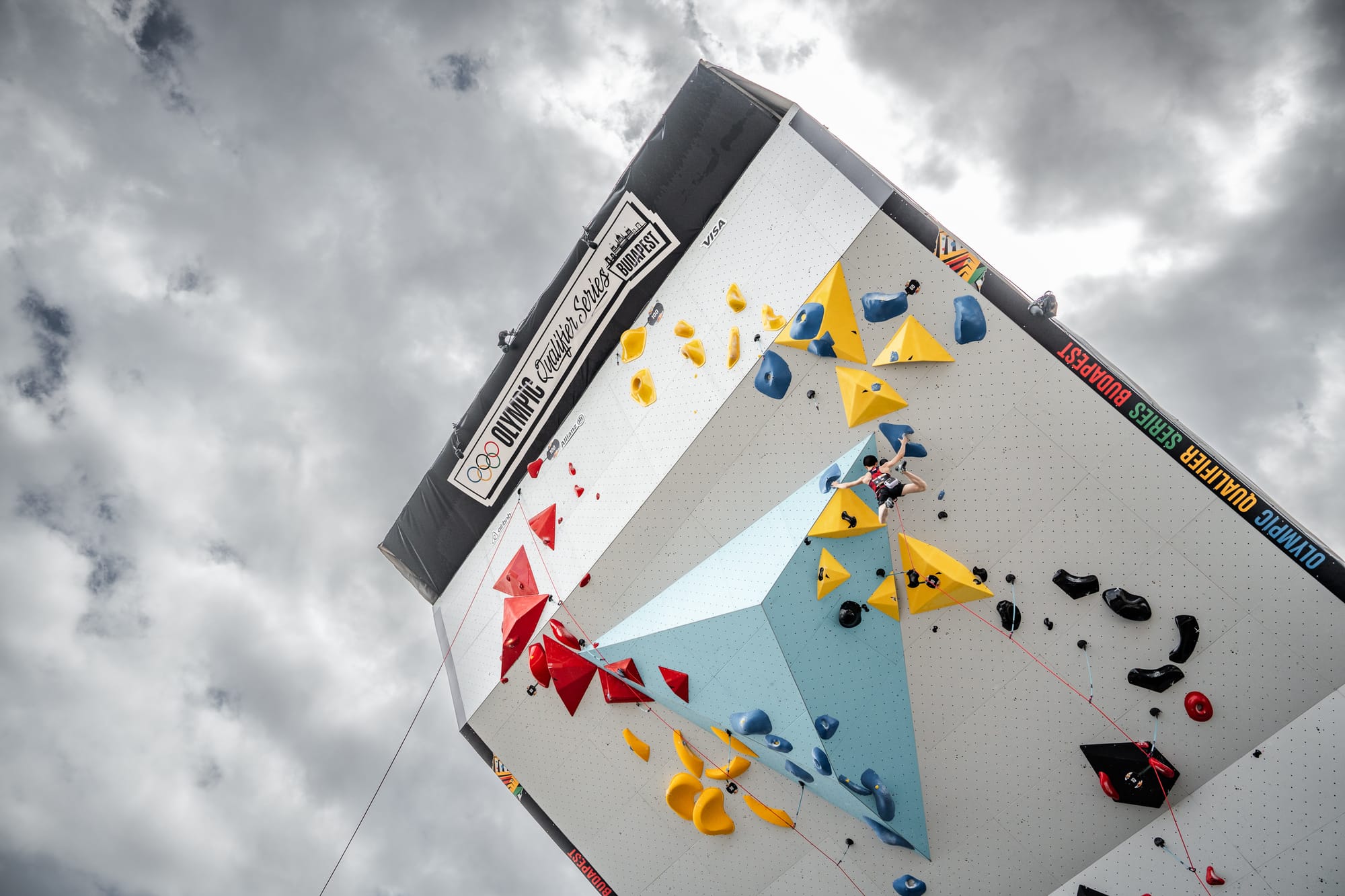
The qualification route in Budapest was very endurance-focused with no real risk, but it was a lot easier than Shanghai, with multiple athletes getting into the final 5 holds and scoring over 80 points. The female semi-final and final routes spiced things up, with a powerful boulder on the women’s semi-final route just before the headwall and a jump low down in the final route to unsettle the athletes.
The routes for the male athletes were focused on endurance with little risk in the qualification round, and the semi-final and lead routes were similar. But they were still enjoyable for the athletes. Adam Ondra told me after the competition, “I think there were really good lead routes throughout the competition. The route setters did a really good job in terms of creating a complex route that tested the athletes in the best possible way.”
Scoring Across The Styles
Each boulder in the new combined format has an extra low zone added to each boulder compared to World Cups, which means the boulders are longer. However, athletes still have only 4 or 5 minutes to attempt the boulder, which reduces the total number of attempts they can make. The boulders are split into three distinct sections by the scoring holds instead of two, so the route setters have to create three different problems within one climb.
When setting the boulder phase, the routesetters have had to adapt the way they set the boulders. Olga Niemiec told me, “We are mostly focused on the 25 points. This is the most important thing for us. But also the 10 points. It really matters in terms of the split for the rest of the field, not just the first three athletes. The five points are not the most important factor. But it’s good if they lose tries to reach the five points, and they have less time to try and get 10, and in the end for, the 25 points.
“We need to be really focused on a whole boulder, like from the bottom to the top, how much time do they need, and how many attempts they can have on the top section. This is the biggest challenge.”
The low importance of the 5-point low zone can be seen in the boulders, where athletes often traverse into the 5-point zone, as the boulders are still set on the same side wall as World Cup boulders.
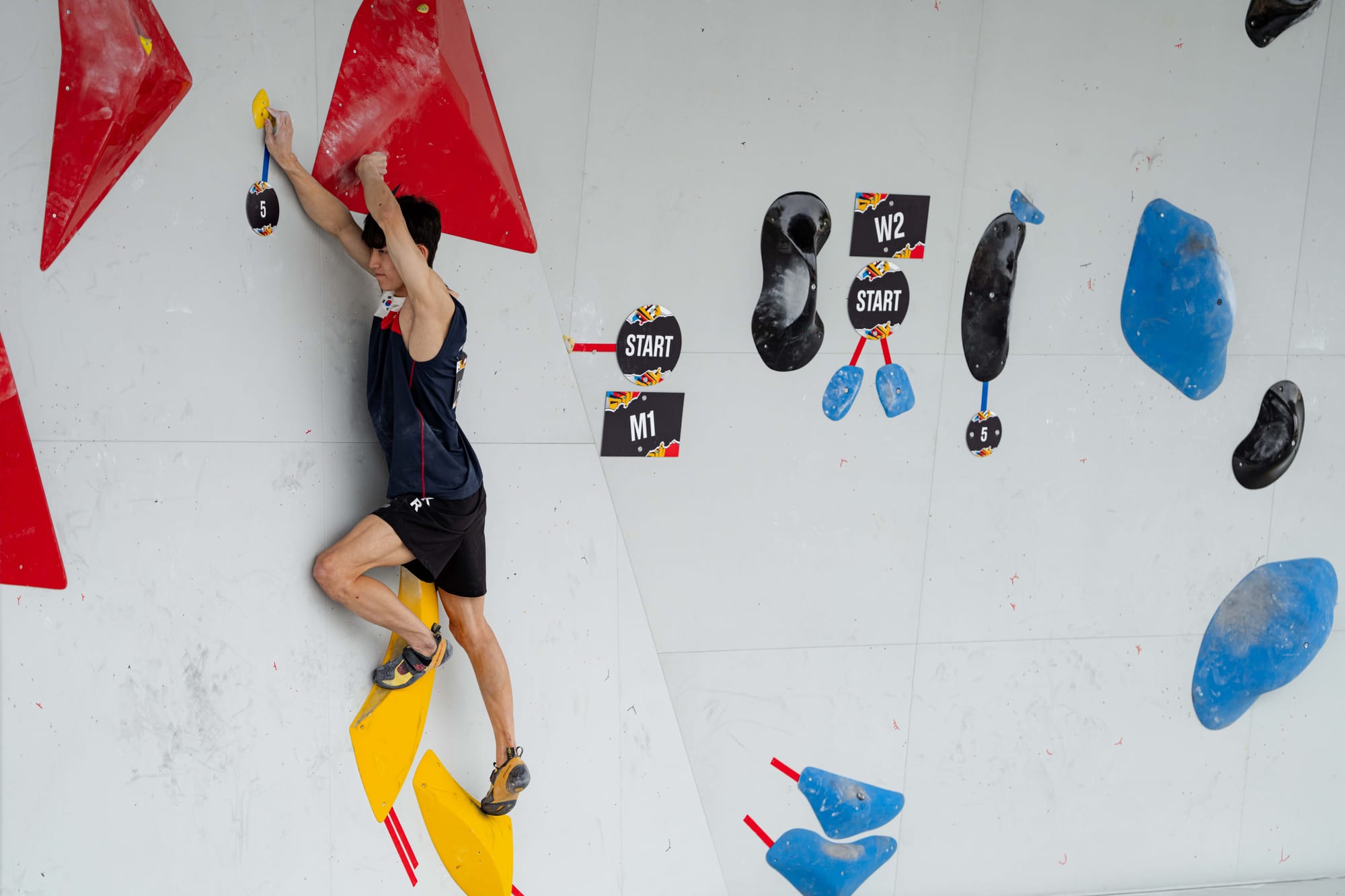
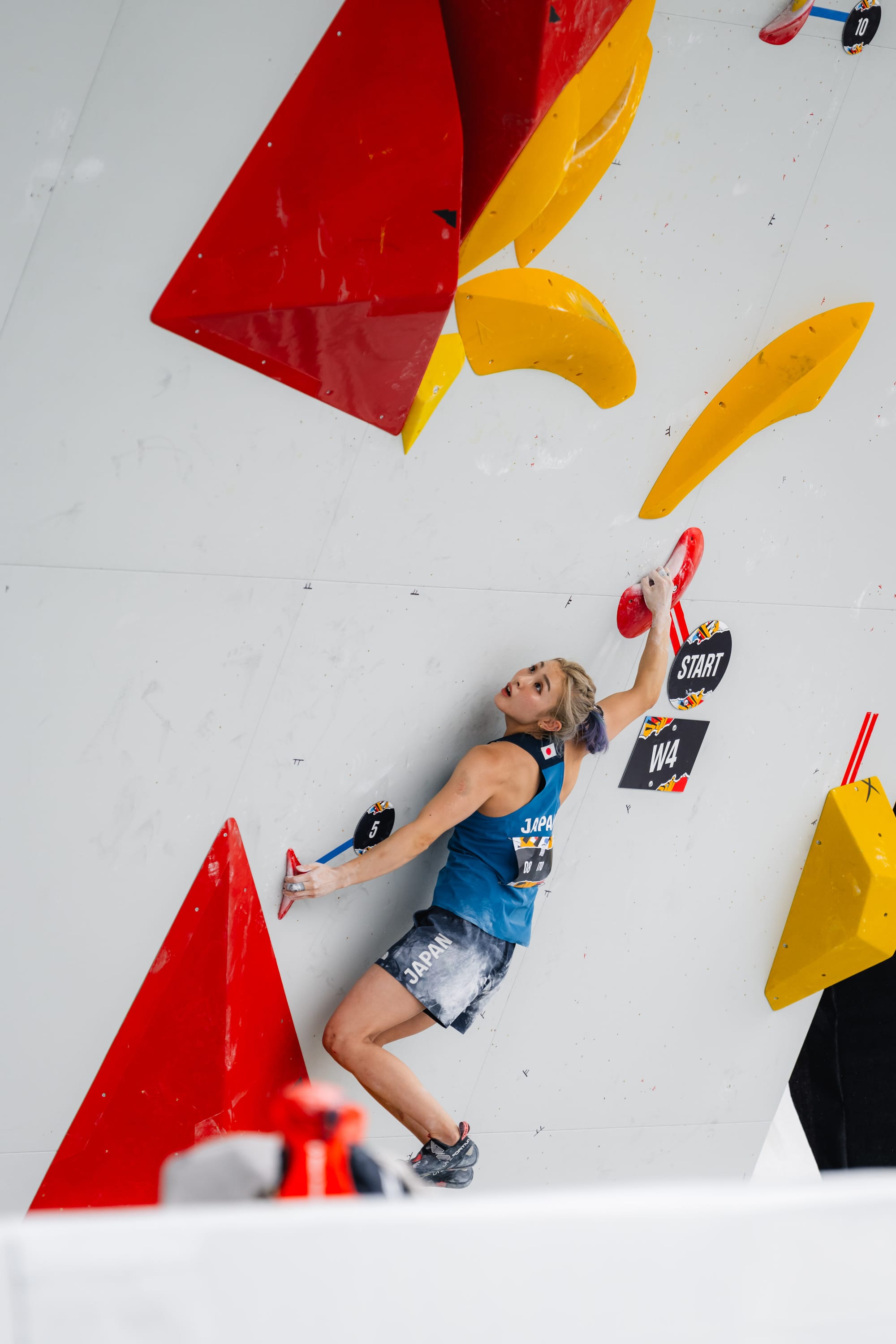
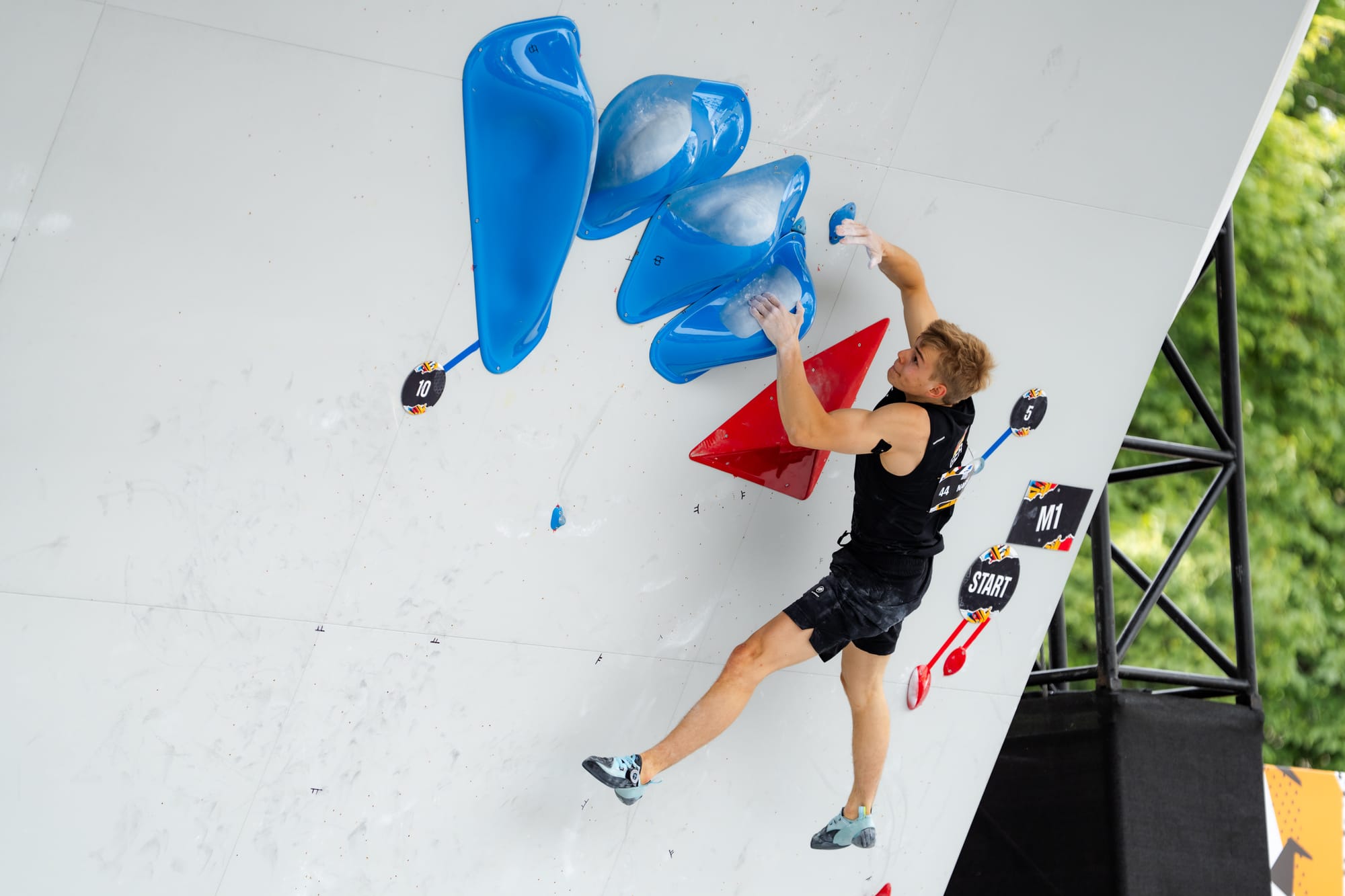
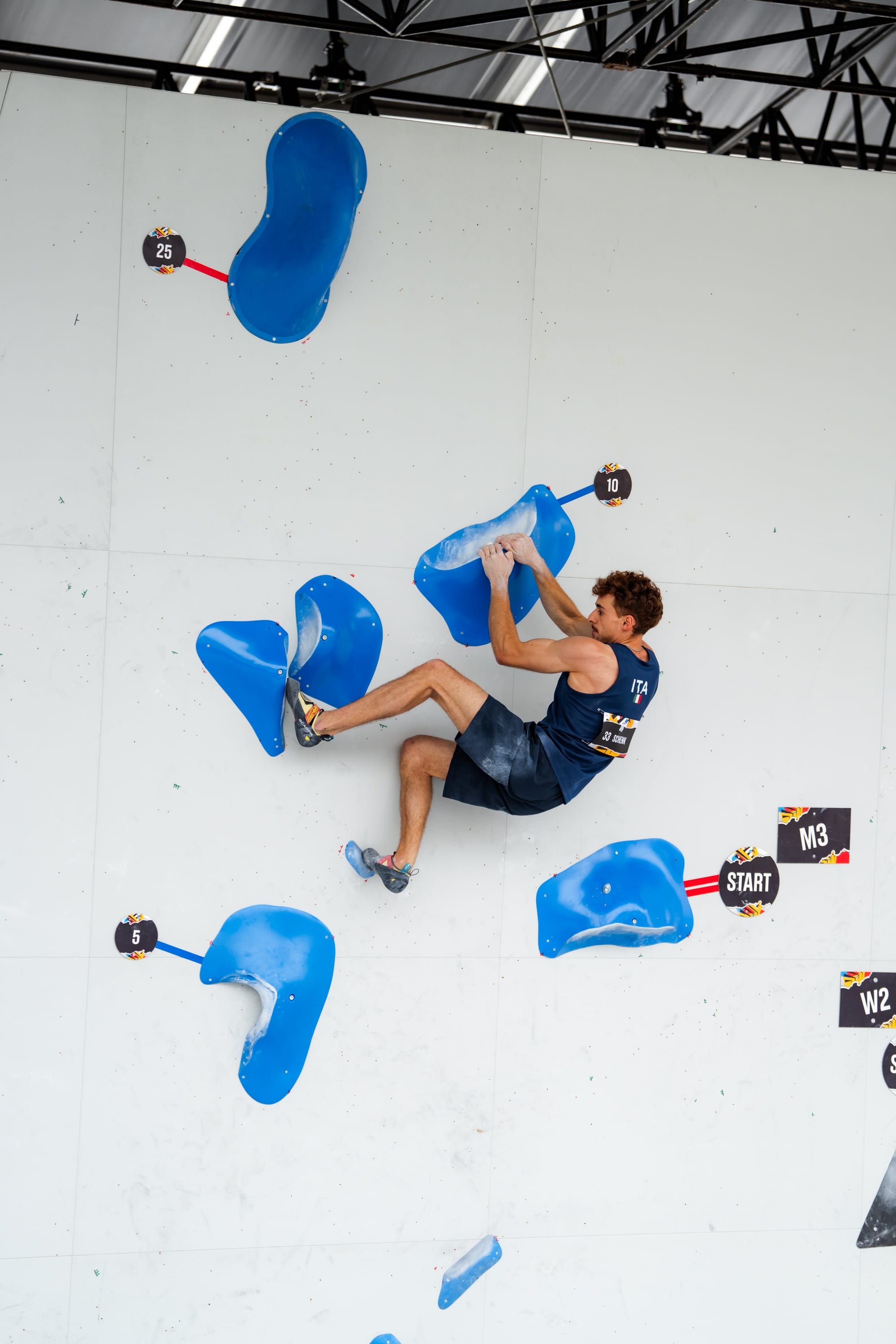
Some boulders where the low zone was close to the start, or a traverse across the wall © Lena Drapella / IFSC
There was only one semi-final boulder in both male and female semi-finals in Budapest, where one or two athletes didn’t reach the low zone. There were two boulders in the female final and one in the male final where an athlete didn’t reach the low zone.
The high zone worth 10 points is really important, especially on the boulders, which didn’t get many tops. On boulders where the low zone is easy to reach, the boulder can feel more like a one-zone World Cup problem, with the high zone playing the part of the zone.
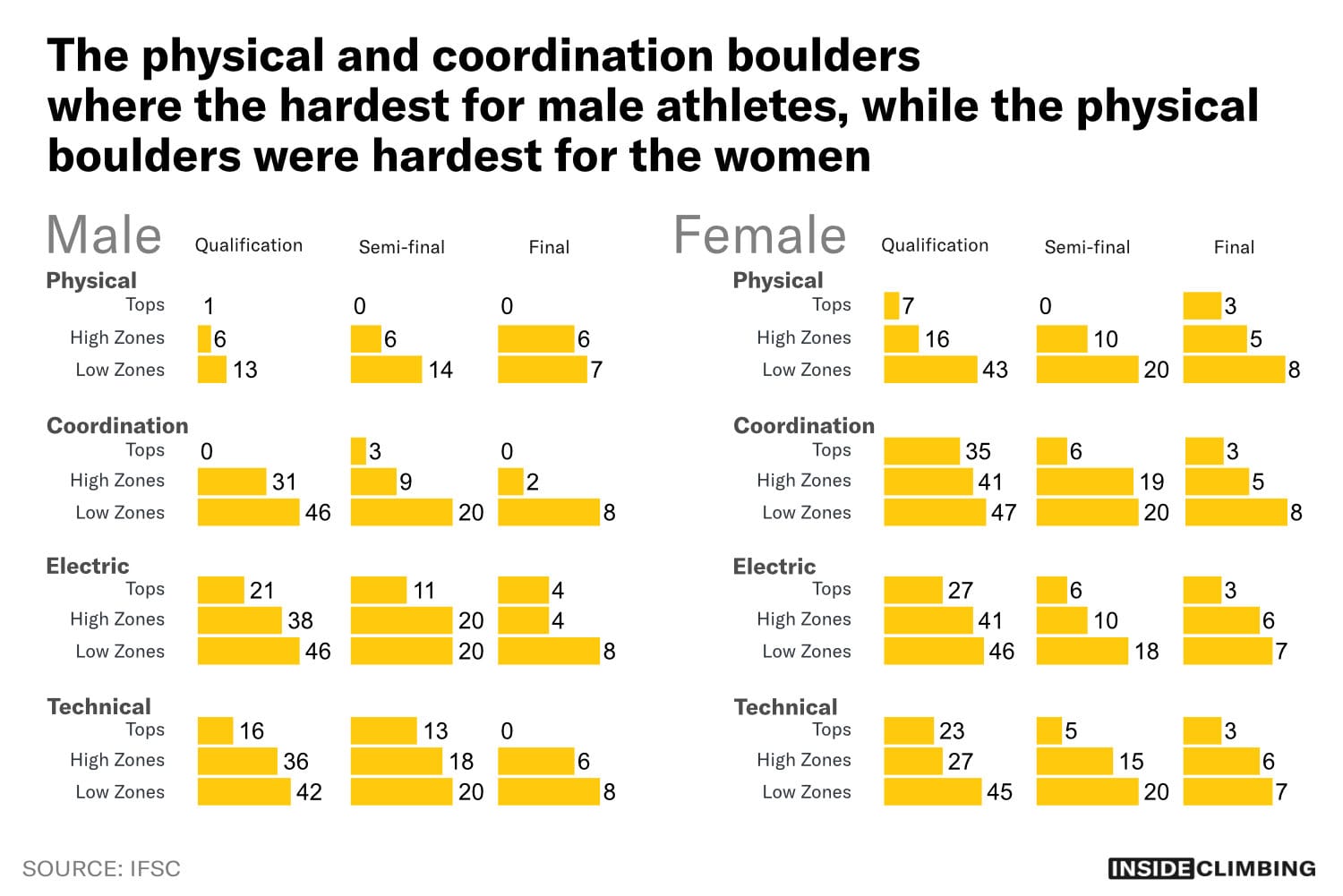
I have been convinced that a point system for bouldering is more understandable than the current World Cup format. The combined points system could be better, but I hope a points system of some form comes to the Boulder World Cup circuit.
Who is Behind the Route Setting?
The routesetting team in Budapest was similar to Shanghai, with Sergio Verdasco joining the team in Budapest. The same team will be setting in Paris along with 2 French routesetters. The routesetting team is split between the two disciplines.
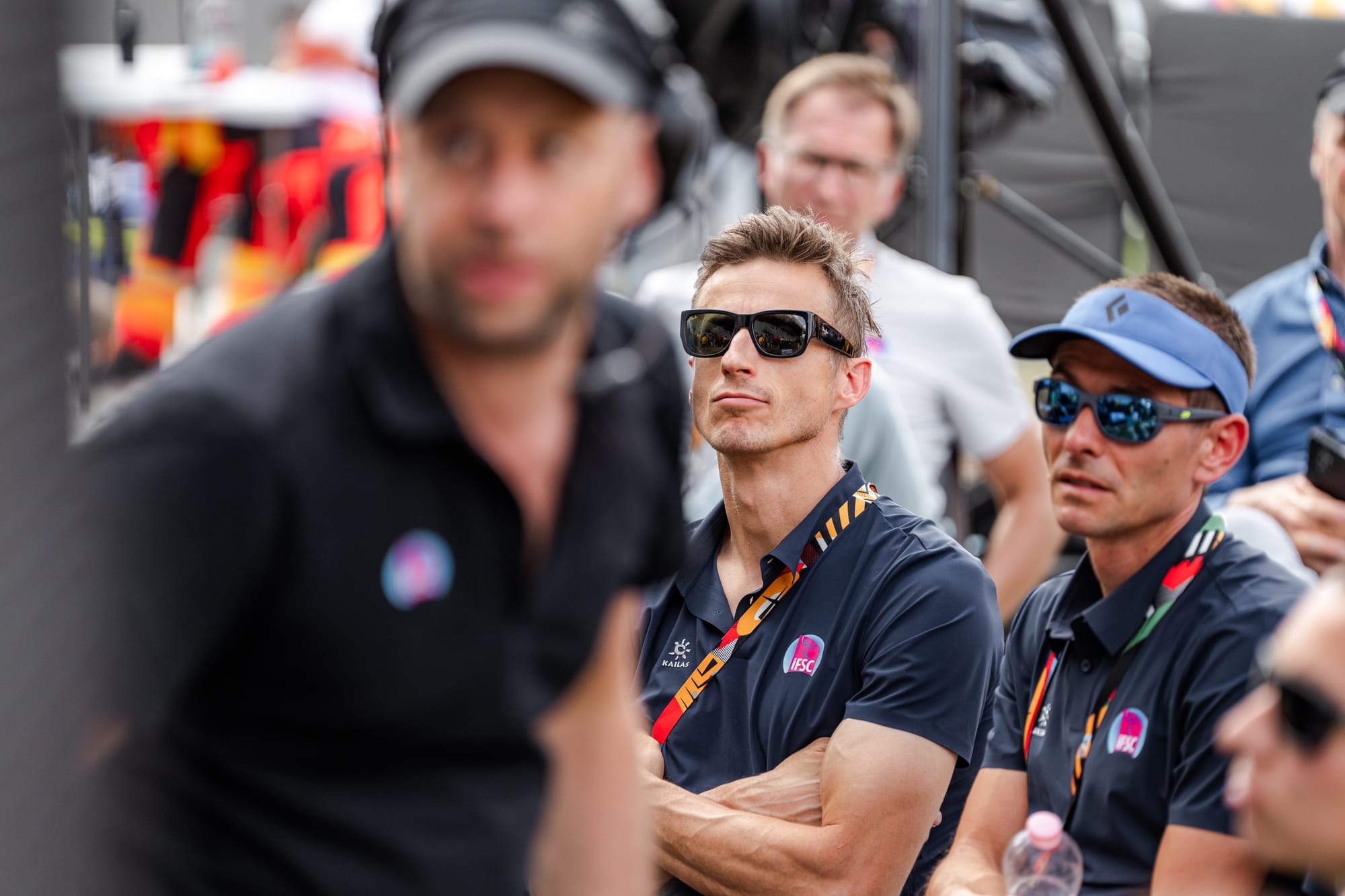
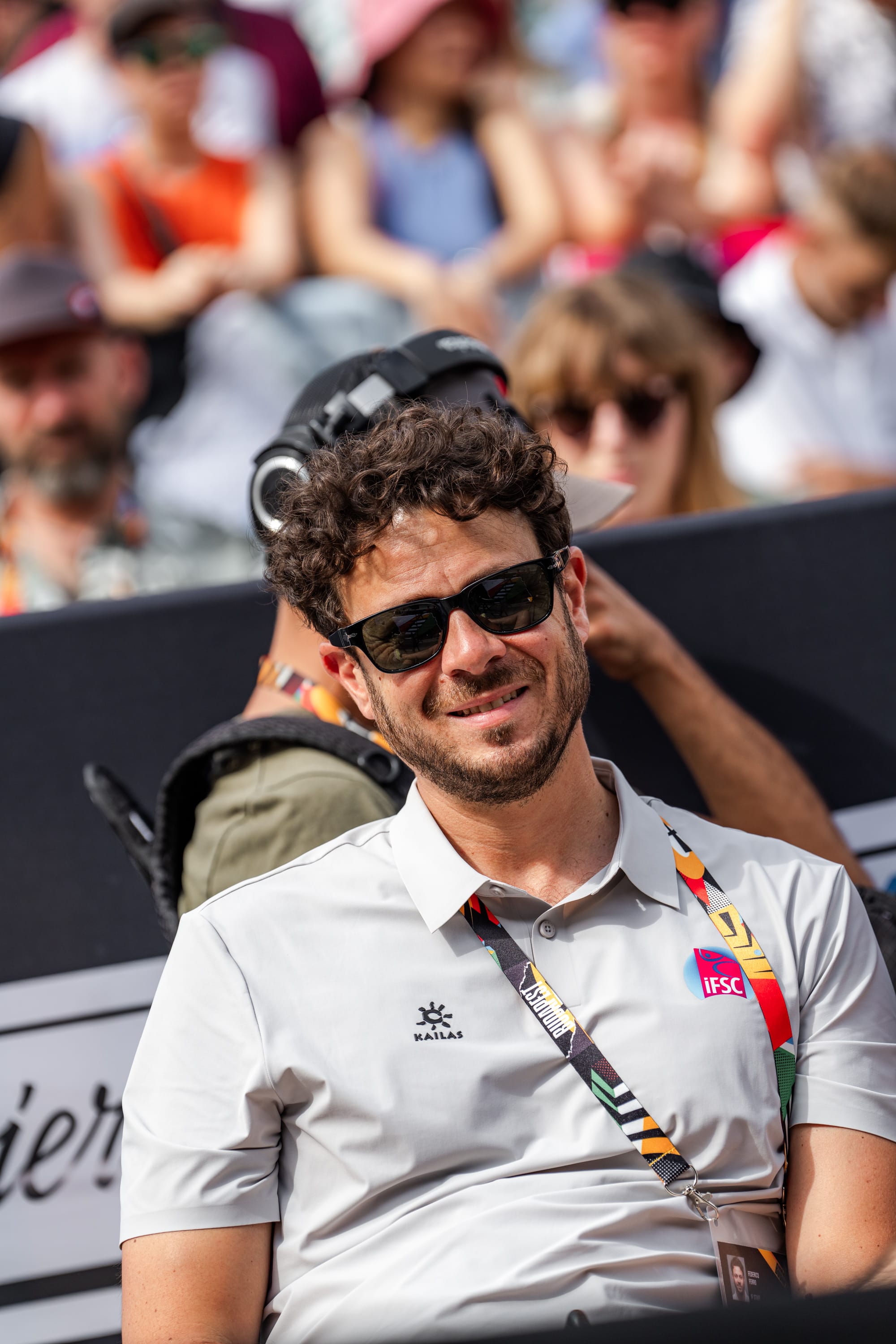
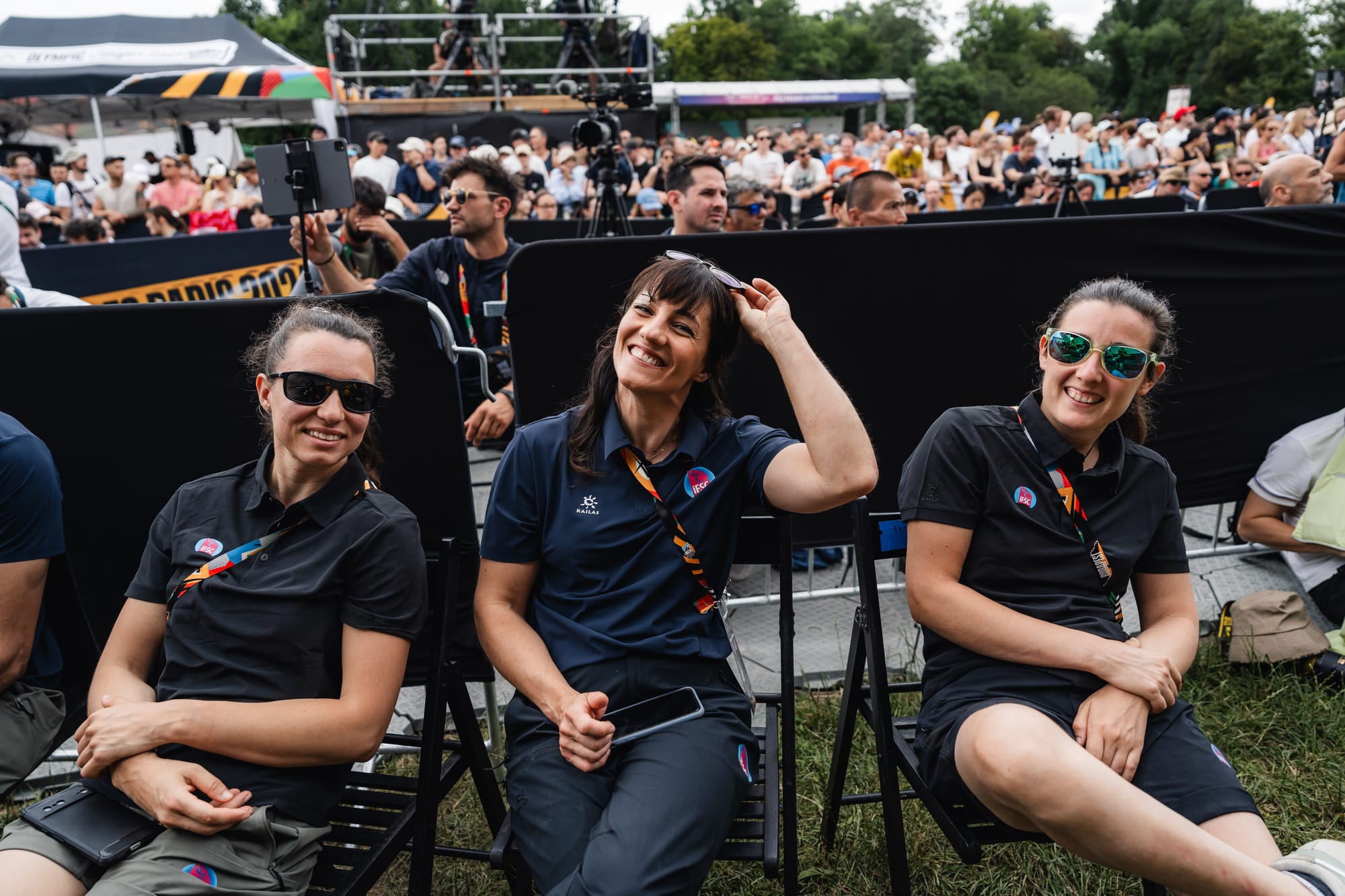
Some of the routesetters watching on in Budapest © Lena Drapella / IFSC
Boulder Routesetting Team
- Garrett Gregor (USA) - Head Routesetter
- Tsukasa Mizuguchi (Japan)
- Olga Niemiec (Poland)
- Tomasz Olesky (Poland)
- Remi Samyn (France)
- Sergio Verdasco (Spain)
Lead Routesetting Team
- Martin Hammerer (Austria) - Head Routesetter
- Akito Matsushima (Japan)
- Adam Pustelnik (Poland)
- Brad Weaver (USA)
- Jan Zbranek (Germany)
Unlike at the Tokyo 2020 Olympics, there are two female setters in the boulder team: Tsukasa Mizuguchi from Japan and Olga Niemiec from Poland. Mizuguchi has route-set since high school and has routeset at national and international competitions in Japan. She became an IFSC routestter through the IFSC Routesetter diversity program in 2021. Niemiec became the first female Polish IFSC routesetter back in 2022, and she was part of the team that set at the 2023 World Championship in Bern last year.
I asked Niemiec in Budapest about what it was like having 2 female routesetter on the team. “We now know how to work together. It’s really good, and we are both focused on the female boulders. We try to understand our level of us as setters and the athletes. It’s super nice to work with her as a second female setter. We climb differently, so in some styles, she’s better. In some styles, I’m a bit better, so it’s really balanced, I would say.”
I asked Adam Pustelnik how the two teams work together.
“In reality, right now, we kind of function more on the idea of where the top athletes should be and how the spread should look, and we align on this. At the beginning of the setting, we’re like, ‘Okay, we try to follow this’, then we try to focus on our own discipline.
“Of course, after a round where things go a little bit out from the guidelines, we talk afterwards ‘, Okay, what are you gonna do, guys? What are we gonna do?’ but we just communicate, ‘This is our plan’. We look at them, and usually, the plans align because we watch our disciplines and we see how things happen.
“We are all route setters that can judge what is happening on the other’s field of play, so we don’t need to speak that much. But we do work as a total team as well because we support each other when things go wrong as well, and we support each other when things go good.”
In Paris at the Olympics, the routesetters will have a longer than in Budapest. “It’s more or less one and a half weeks to set. And we will have more days and fewer rounds.” Niemiec said. “We will really have time to put the boulders on the wall, to test them well, to think about them and to check them.”
The team had learned a lot from Shanghai, and you can tell by the rebalancing between the disciplines. Pustelnik told me, “We learn as well, and we make mistakes, but we know that we need to do as route setters. We need to align on things as well and just calibrate a little bit because the reality is that it’s small mistakes that make the big things happen. These are in route setting things like twisting a hold by a few degrees this way or that way, and suddenly things go from impossible to too easy.”
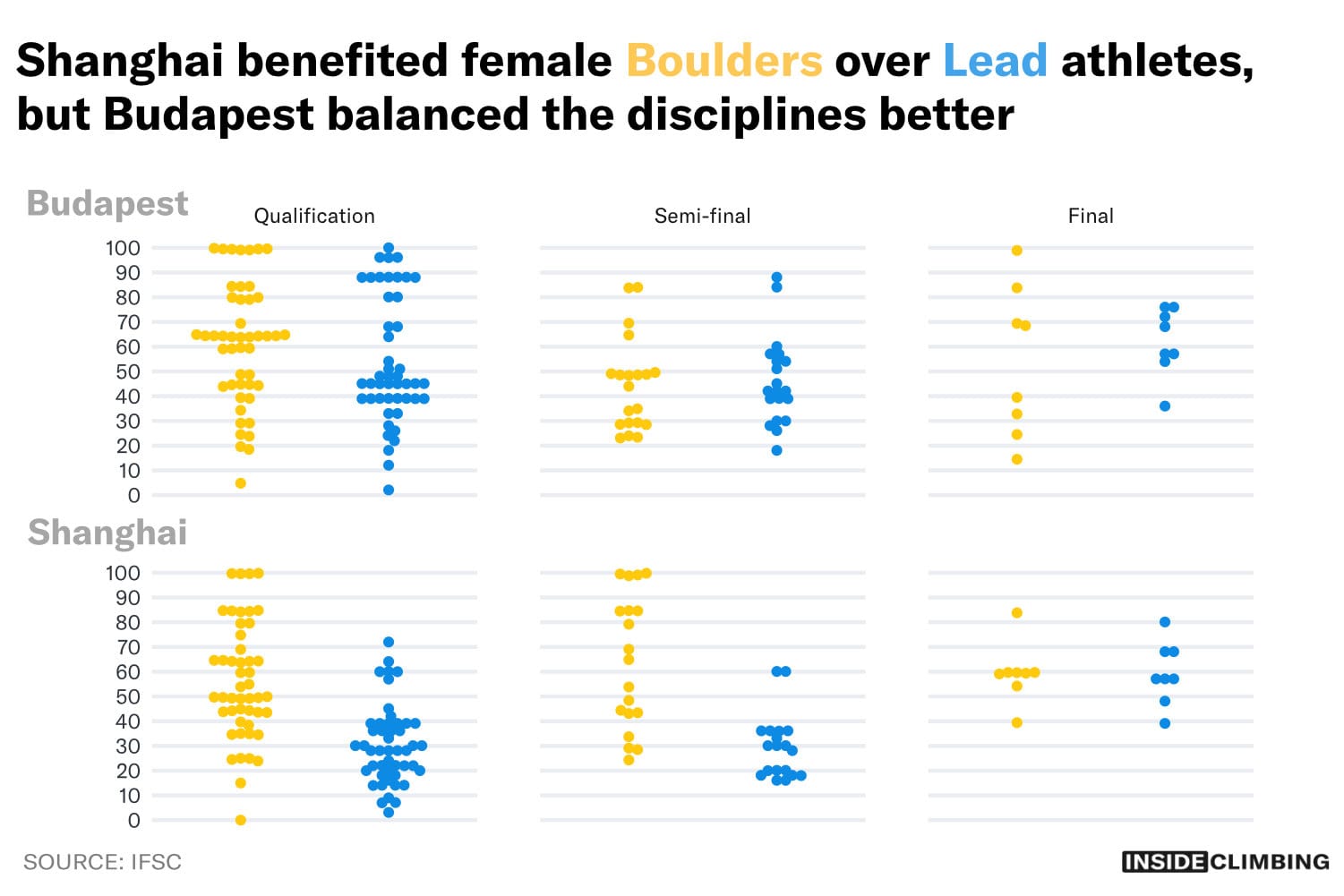
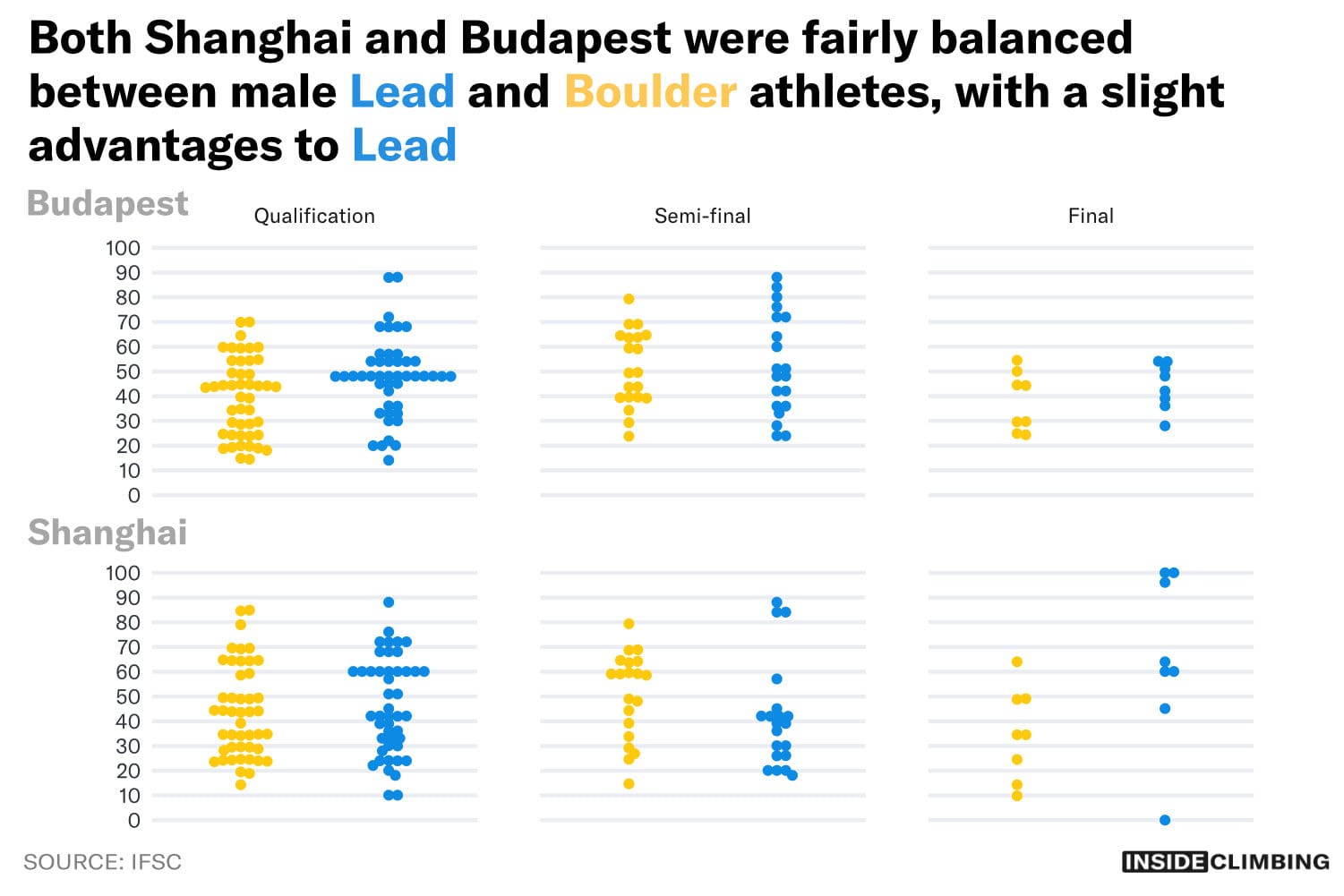
“We know each other a bit better than in Shanghai because Shanghai was the first event where we were working together as a team,” Niemiec said. “This one was the second time. So it was a bit easier to work with each other, and we also had more time here. I think it worked out better.”
Setting Physical Boulder Problems
The fourth male boulder in the qualification round was savage.
Starting with pinches on the steepest part of the wall, climbers would have to thug their way through a set of pinches into a steep compression problem. “It’s like the Big Island,” Yannick Flohé told me, “You really only get one attempt”. Adam Ondra wrote on Instagram after the round that the boulder was “one of the best problems I have ever climbed on a comp”.
The boulder was set by Barna Kerényi, the only Hungarian setter who joined the team. Budapest was his first time routesetting at an international competition.
“I was quite confident that we would reach the 3 or 4 tops [on M4 in qualficiation]”, Kerényi told me on Monday after the event. “After a while, when I saw that even Yannick couldn’t do it, I was a bit worried. But then Albert just cruised it, so he saved it. It was nice. It’s hard to imagine what they are capable of. So, in the end, I just rely on the headsetter and the other setter who are more familiar with this field. And if they say it’s okay, I trust them.”
Alberto Ginés López was the only athlete to reach the top. It would be the only top of any of the male physical problems in the whole competition.
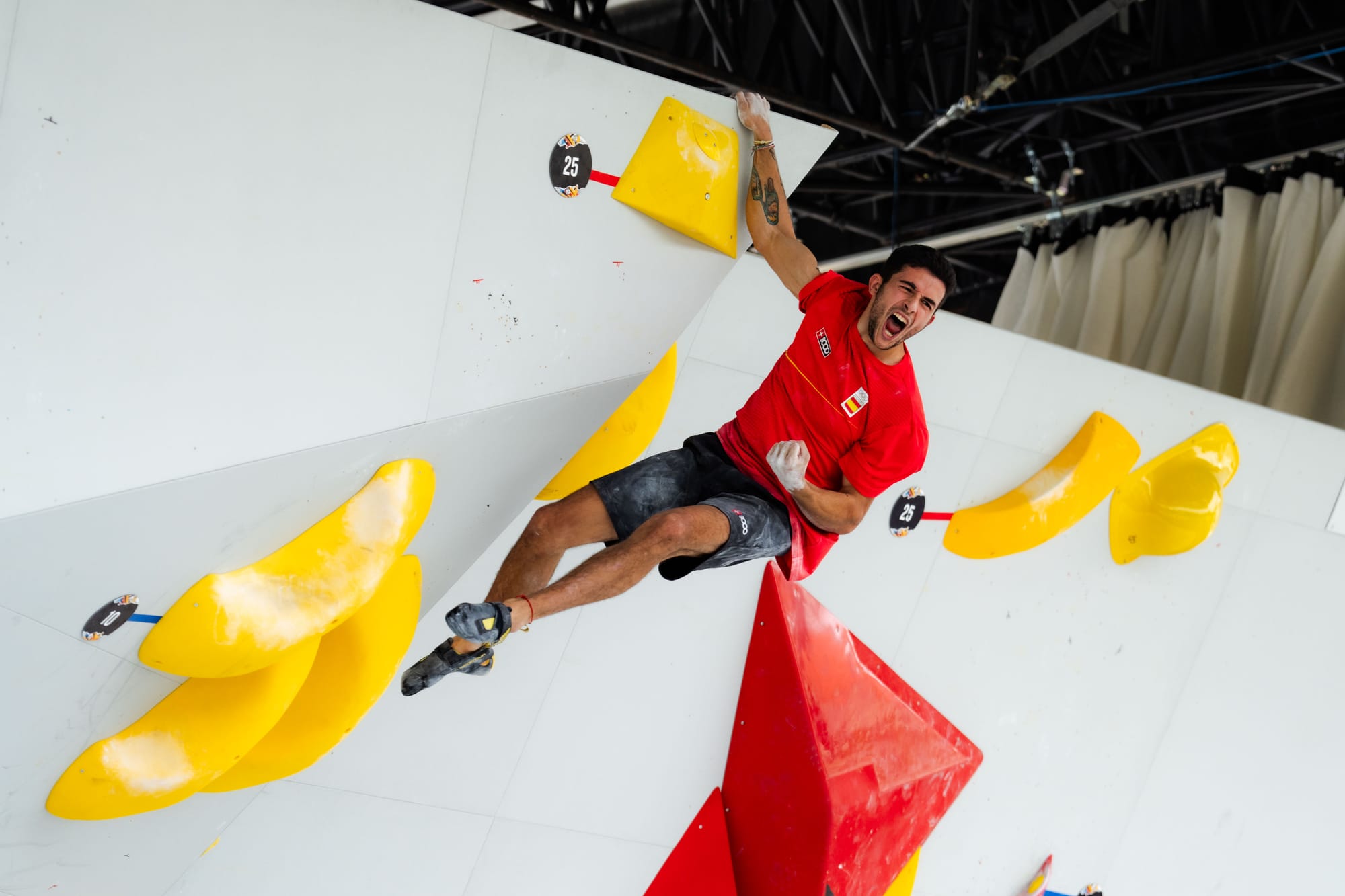
“I knew that I had to use these holds on this profile of the wall. And then it was basically just on sighting.” Kerényi told me about setting the boulder. “I put the holes on the wall, and I was super lucky. I didn’t really have to change anything. I just put it on. I showed the headsetter, Remi [Paris Headsetter Garret Gregor had to leave early for the test event in Paris] the concept, and he was happy with it, and then after that, we tried it, of course. We had to make some tiny adjustments like some of the holds had to be turned a few degrees. But other than that, it was all done.”
And none of the setters did all the moves. “Sergio was super close on the first move, but he couldn’t stick it if I remember correctly,” Kerényi said. “Then, no one could manage to reach the third one. Sergio was close but with a completely different beta. No one else tried it the way he did it. After the final change, no one did the top move. The middle section the testers could do. The top move one of the guys did with a slightly better hold. But then we changed it, and then we couldn’t do it anymore.”
When I asked if there was anything he would change about the boulder, Kerényi said, “I would just change the angle of the second hold just a tiny bit to more horizontal, to have more climbers to have at least a chance to get to the final section.”
Setting power problems for the best in the world is hard. In Budapest, the routesetters pushed the limit maybe too much for the athletes in hot conditions where athletes climb 4 days on.
Niemiec told me after the female final when I asked about the difficulty of the semi-final physical boulder, “So we played, we wanted to challenge the athletes, we wanted to see actually where’s the limit. It was a bit too hard, obviously, but that was a tiny, I would say, tiny, mistake.
“For the females, it was a really complicated boulder. They made a lot of mistakes in the middle section. So it’s good we pushed here because now we have information for Paris, and that’s the most important thing for us.
“Of course, it would be better to have one or two tops on this boulder, but well, sometimes you push and you achieve a goal, and sometimes you push and it’s a bit too much. That’s how it was here.”
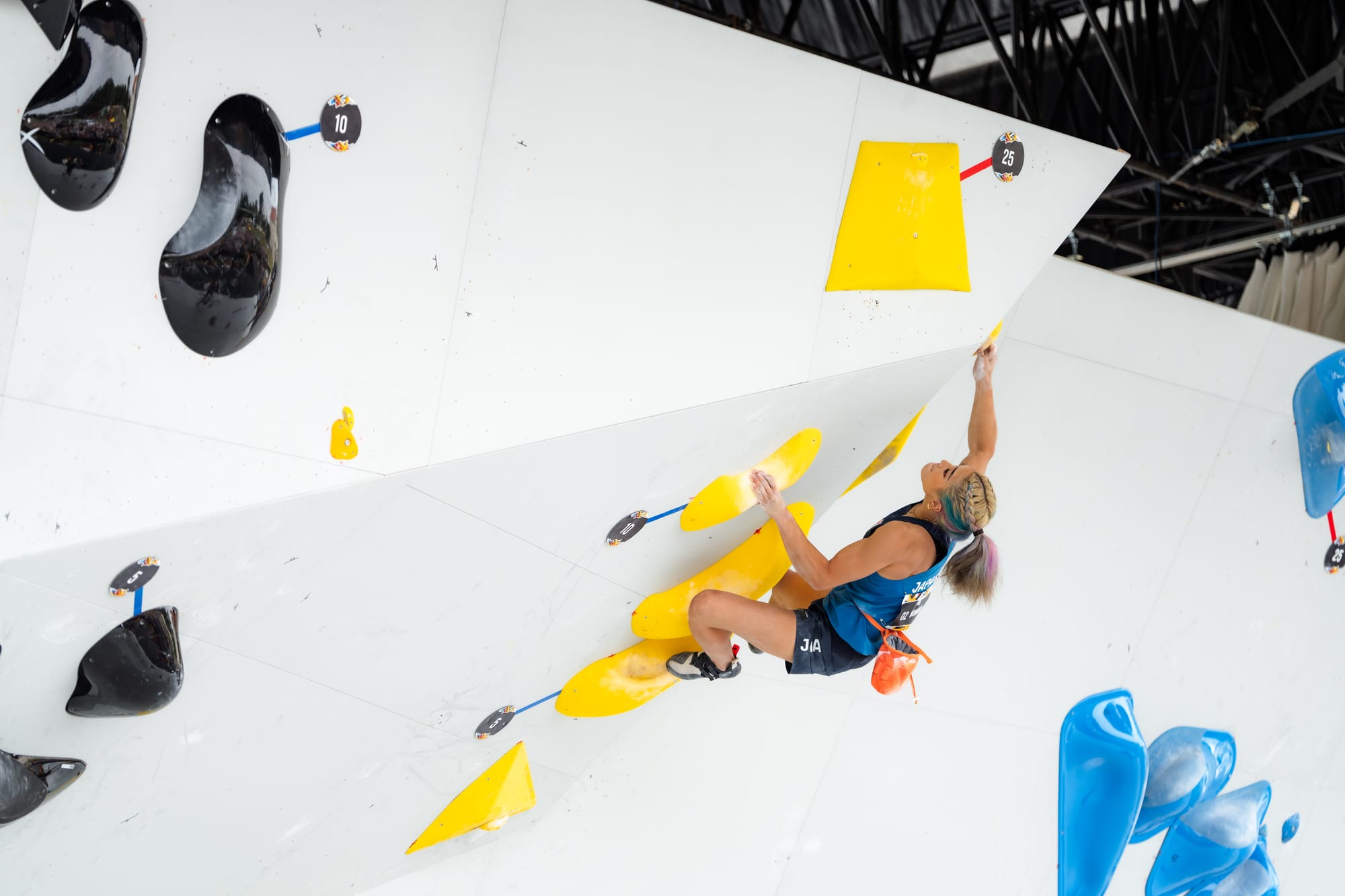
The physical problems only got 1 top across all rounds for the men and 10 for the women: 0 in the semi-finals, 7 in qualification and 3 in the final.
In Paris, Janja Garnbret will be competing, and she loves being challenged by physical boulders; I asked Niemiec if that complicates the setting.
“Actually, in my point of view, it helps us. Janja is the only one who can do some of the moves. So, sometimes we can push more because we are more secure that probably [the boulder] will work for Janja and that she will be the only one who can make it to the top. So, in that case, instead of zero, we have one.”
Correction August 5th: A previous version of this article stated that the Buadpest OQS Boulder was the Titan - it was not. It was a wall from Walltopia with similar angles to the Titan, but wider to accommodate more athletes. We regret the error.





